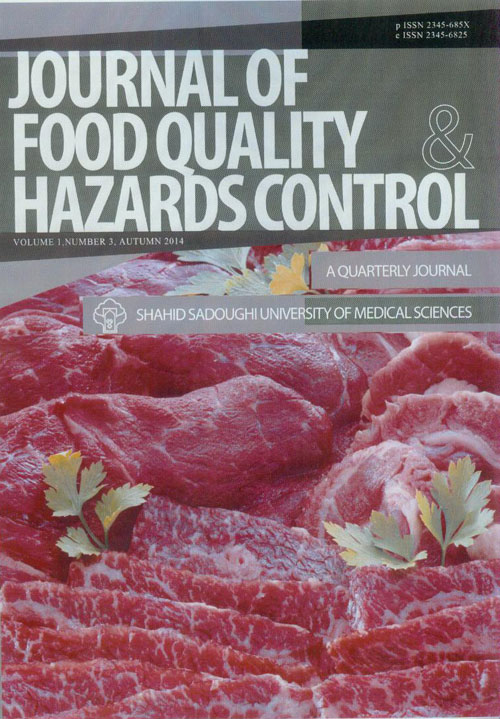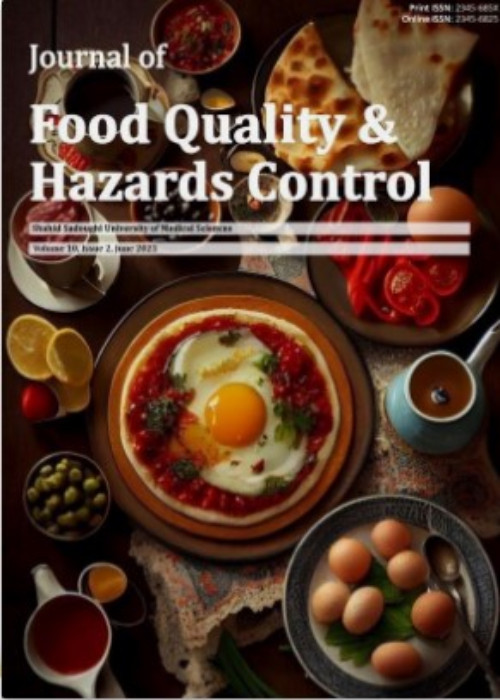فهرست مطالب

Journal of Food Quality and Hazards Control
Volume:1 Issue: 3, Sep 2014
- تاریخ انتشار: 1393/06/27
- تعداد عناوین: 8
-
-
Pages 67-71Beverage emulsions are systems that are composed of two liquids including oil and water which are prepared by homogenizing oil phase in an acidic aqueous phase. They must be stable in both concentrated and diluted form for a period of 6-12 months upon standing at room temperature. Two immiscible phases contained systems are thermodynamically unsta-ble. In other words, they are vulnerable to break down over time by different process such as flocculation, coalescence, gravitational separation, phase inversion and ostwald ripening. The rate of destabilization depends on physicochemical properties of two phases, interfacial layer characteristic and the components present in both continuous and dispersed phase. However, beverage emulsions are thermodynamically unstable; it is possible to make it ki-netically stable using an appropriate emulsifier with respect to emulsion properties, change the dispersed phase characteristic in a way that retards its upward movement. In this article, the most common factors affected on beverage oil-in-water emulsion stability are reviewed. We will also introduce some solutions to improve beverage emulsion stability.Keywords: Beverages, Emulsions, Thermodynamics, Kinetics
-
Pages 72-76BackgroundHistamine is a food-borne chemical hazard which causes scombroid poisoning. The efficiency of histamine recovery from fish is greatly influenced by selection of an appropriate extraction solvent. Hence, in this study the efficiency of different extraction solvents on recovery of histamine from fresh, frozen and canned fish was evaluated.MethodsFresh, frozen and canned rainbow trout samples were homogenized in six different extraction solvents including 0.1 N hydrochloric acid, 5% trichloroacetic acid, 75% methanol, 75% ethanol, 75% methanol-0.4 N hydrochloric acid and 75% ethanol-0.4 N hydrochloric acid. Samples were evaluated for recovery of known quantities of histamine added to fish tissue prior to extraction. The percent values of the recoveries were compared using ANOVA (SPSS 16.0).ResultsFindings of this experiment indicated that different extraction solvents provided different overall mean recoveries for histamine in fish tissue. Using a combination of acid and organic solvents provided a more efficient extraction solvent for histamine from fish tissue than acid or organic solvents alone. In addition, among the solvents used in this study, 75% ethanol-0.4 N HCl resulted in a more complete recovery of added histamine from fresh, frozen and canned fish tissue.ConclusionIn order to obtain a more accurate measure of histamine in fish tissue, 75% ethanol-0.4 N hydrochloric acid appears to be a good choice for extraction.Keywords: Histamine, Solvents, Fish Products, Analysis
-
Occurrence of Aflatoxin M1 in Pasteurized and Traditional Cheese Marketed in Southern Khorasan, IranPages 77-80BackgroundAflatoxin M1 (AFM1) is a toxic and carcinogenic mycotoxin which after presence in milk and dairy products such as cheese and butter could make them as contaminated food. The main objective of this study was to evaluate the concentration of AFM1 in pasteurized and traditional cheese marketed in Southern Khorasan, from December 2011 to January 2012.MethodsA total of 102 cheese samples (including 43 non-pasteurized traditional and 59 pasteurized cheese) were analyzed for detection of AFM1. The samples were collected ran-domly from three major cities of Southern Khorasan province, Iran. A rapid and sensitive indirect competitive Enzyme Linked Immuno Sorbent Assay (ELISA) method using monoclonal antibody was used to measure AFM1 concentration in the samples.ResultsAccording to the results of this study, AFM1 was detected in 14 (32.55%) traditional and 21 (35.59%) pasteurized cheese samples. In total, 25.42% of pasteurized and 27.90% of traditional cheese samples were contaminated at above level of the Iranian standard limits (50 ng/kg).ConclusionConsidering high contamination level of both pasteurized and traditional cheese products in Southern Khorasan, it is recommended to establish continuous monitoring program of AFM1 by food safety agencies in order to control the incidence of mycotoxin contamination.Keywords: Aflatoxin M1, Cheese, Iran
-
Pages 81-84BackgroundMycotoxins are a group of structurally diverse substances produced by a wide range of moulds. These fungal secondary metabolites, whose presence in feed is unavoidable, can impose hazards to human and animal health. Continuous concern about potential effects of mycotoxins in the human diet has led to an increasing interest in researches about fungi and mycotoxin production. The aim of this work was to assess fungal contamination of feed material manufactured in Iran with emphasis on its importance in safety of animal origin foods.MethodsSamples included 16 poultry and 15 aquatic feed which collected from 4 and 3 factories, respectively in Markazi province, Iran, in 2012. Then, standard mould count procedure was carried out to determine fungal contamination levels in the samples. SPSS (version 16) software was applied to statistical analysis.ResultsAccording to the results, 6.7% of aquatic and 31.3% of poultry feed samples had fungal contamination. The mean fungal contamination level of poultry feed and aquatic feed samples were 6.4×104±1.12×105 CFU/g and 1.18×103±2.77×103 CFU/g, respectively.ConclusionThis study showed a need for control of fungal contamination in aquatic and poultry feed in Iran. The condition of poultry feed is more problematic than that of aquatic feed, indicating a need to more local work to have least fungal contamination.Keywords: Animal Feed, Food Contamination, Mycotoxins, Food safety, Iran
-
Pages 85-88BackgroundAntioxidant activities of plant extracts are being studied to increase the shelf life of fish products. Some plants such as Urtica dioica L. (nettle) can be a good source of antioxidants. The objective of this study was to evaluate the effects of hydroalcoholic and water extracts of nettle leaf on the chemical properties of superchilled minced meat of the common kilka fish (Clupeonella cultriventris caspia).MethodsOne hundred g of minced meat of kilka was mixed with 200 and 400 ppm of both hydroalcoholic and water extracts of nettle separately, and stored at -2 °C. The Total Volatile Basic Nitrogen (TVB-N) and Thiobarbituric Acid Reactive Substances (TBARS) of the samples were analyzed at days 0, 3, 7, 14, 21 and 28. The statistical analysis was carried out using Duncan’s multiple range tests in MStat-C software.ResultsBoth hydroalcoholic and water extracts of nettle extended the shelf life of minced kilka from 2 days to 8 days. However, no relation (p>0.05) was observed between chemical values and kind of extracts. Also, there was no significant difference (p>0.05) between two concentration levels of extracts and chemical values.ConclusionTreatment levels of nettle extracts could effectively delay chemical deterioration, and extend the shelf life of minced kilka during storage. A combination of superchilling temperature (-2 °C) and treatment of minced kilka with 200 and 400 ppm of hydroalcoholic and water extracts of nettle can extend the shelf life to 28 days. Based on the results of this study, it is proposed that these plant extracts can be used as safe preservatives for minced fish.Keywords: Fish Products, Plant Extracts, Cold Temperature, Food Preservation, Chemical Safety
-
Pages 89-92BackgroundToxoplasma gondii, as an important food-borne protozoan parasite, occurs widely in humans and animals including domestic poultry throughout the world. The goal of this survey was to determine prevalence rate of T. gondii in free-ranging chickens sold in Tunis, Tunisia.MethodsIn the present study, the prevalence of T. gondii in 40 free-range chickens (Gallus domesticus) marketed in Tunis, Tunisia was assessed. Blood and brain samples from each chicken were examined for T. gondii infection using the Modified Agglutination Test (MAT) followed by mouse bioassay and Polymerase Chain Reaction (PCR).ResultsAntibodies against T. gondii were found in all 40 samples (100%) with the titer of 10 in 14 chickens, 20 in 9 chickens, 40 in 3 chickens, 80 in 5 chickens, 160 in 6 chickens, 320 in 2 chickens and ≥640 in one chicken. By the end of the bioassay, we detected Toxoplasma DNA in 15 mouse tissues (37.5%). T. gondii was detected from chicken tissues with different antibody titers.ConclusionResults of this study indicated very high environmental contamination with T. gondii oocysts around Tunis city. The high seroprevalence refers to the public health importance of chickens as source of zoonotic toxoplasmosis to human which suggests that consumption of poultry meat in Tunis city may pose a potential threat to pregnant women health and should be given attention.Keywords: Chickens, Toxoplasma, Serology, Biological Assay, Polymerase Chain Reaction
-
Page 93
-
Page 94


